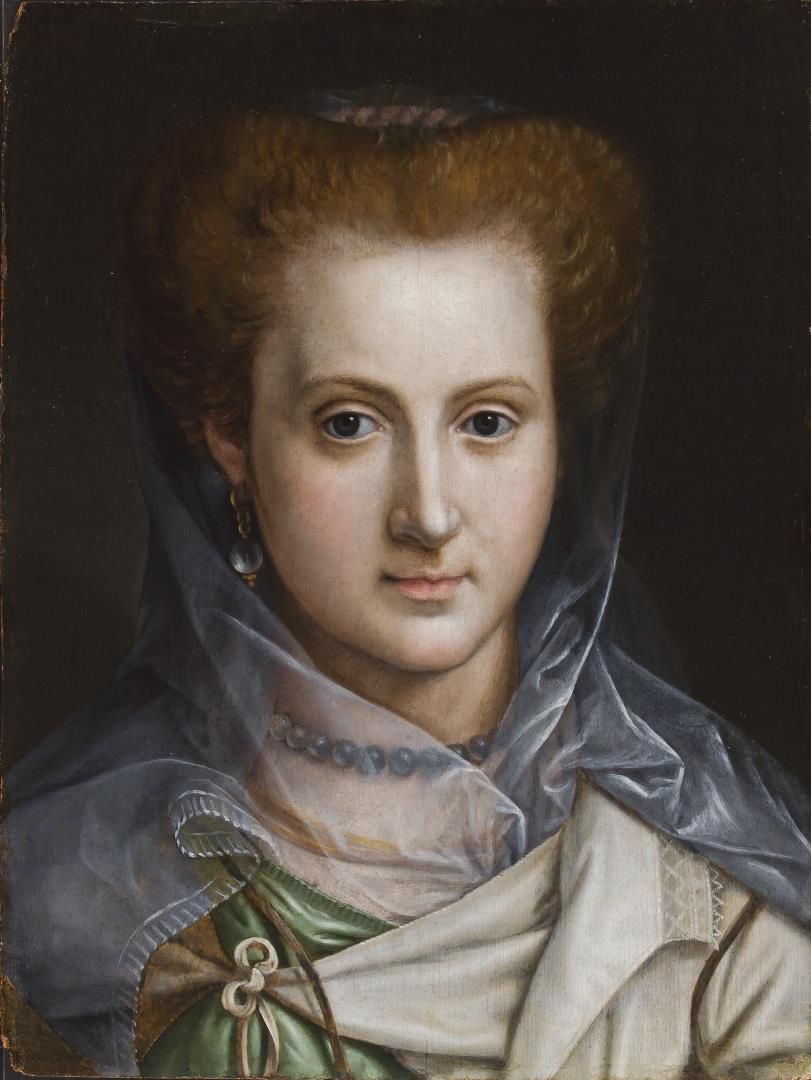The online collection and picture sale

Bust of a Woman with a Veil
Anonymous, Flemish
Third quarter of the 16th century
Oil on oak panel
47 x 36 cm
c. 1550-1570
Third quarter of the 16th century
69/367
Bequeathed by Mercedes Basabe, widow of Manuel Taramona, in 1953
With attentive eyes, blushing skin, and a hovering smile, the woman portrayed here emerges from an undefined space to engage us with a confident, penetrating gaze. Although her identity remains a mystery, this brilliant oil painting encodes her status in the conventions of beauty and modesty of Renaissance Florence. The painter, through extraordinary sensitivity and attention, describes the textures of her dress, single earring, elegant strand of black pearls and golden chain, all of Tuscan manufacture. More than beautiful objects, these are signs of her status: they exhibit, quite precisely, the restrained luxury that was required of well-to-do Florentine women according to the sumptuary laws (Provveditori alle Pompe) that regulated displays of wealth. For Florentines, ornamenting the female body was a matter of civic consequence. As one statue proclaimed, a woman's jewels, "if they are worn in moderation, add to the honor and splendor of the city". According to laws passed by Cosimo de Medici in 1562, Florentine women were permitted only one string of pearls (of a maximum value of 500 scudi). "That much we grant", the legal code reads, "because all ladies have pearls [...] necklaces of gold and silver without enamel they may wear as stated in the law, for this is an investment in capital". We see the same adherence to these laws of modesty in portraits of famous Florentine women, such as Bronzino's famous portrait of Eleonora di Toledo, consort of Cosimo de Medici.
Interestingly, technical studies have revealed that this portrait was not painted in Florence, but rather in Antwerp, the commercial and cultural capital of Northern Europe. Artistic exchange between Italy and the North extends back into the fifteenth century, when many expatriate Florentine merchants in Bruges commissioned important altarpieces and portraits from local artists who excelled in the use of oil paint. innovation, closely associated with early Netherlandish painters, permitted unrivaled attention to detail and naturalism through translucent layers of oil and pigment. In the sixteenth-century, when this portrait was painted, Northern artists had begun to look to Italy for their pictorial models, producing images that marry Italian style and the highly finished, "realistic" mode already associated with Netherlandish painting. This enigmatic portrait embodies that exchange. Though anonymous and silent, she speaks an international language of beauty. [Edward H. Wouk]
Selected bibliography
- Lasterra, Crisanto de. Museo de Bellas Artes de Bilbao : catálogo descriptivo : sección de arte antiguo. Bilbao, Museo de Bellas Artes de Bilbao, 1969. p. 151, n° cat. 367. (Con el título Busto de mujer con velo, y como ANÓNIMO ITALIANO DEL SIGLO XVI).
- Museo de Bellas Artes de Bilbao : guía. Bilbao, Bilboko Arte Ederren Museoa-Museo de Bellas Artes de Bilbao, 2006. p. 33.
- Musée des Beaux Arts de Bilbao : guide. Bilbao, Bilboko Arte Ederren Museoa-Museo de Bellas Artes de Bilbao, 2006. p. 33.
- Bilbao Fine Arts Museum : guide. Bilbao, Bilboko Arte Ederren Museoa-Museo de Bellas Artes de Bilbao, 2006. p. 33.
- Museo de Bellas Artes de Bilbao : guía. Bilbao, Bilboko Arte Ederren Museoa-Museo de Bellas Artes de Bilbao, 2011. p. 33, n° cat. 19.
- Bilboko Arte Ederren Museoa : gida. Bilbao, Bilboko Arte Ederren Museoa-Museo de Bellas Artes de Bilbao, 2012. p. 33, n° cat. 19.
- Wouk, Edward. "Entre Amberes y Florencia : el enigma de ”Busto de mujer con velo” = Between Antwerp and Florence : the enih¡gma of ”Bust of a Woman with a Veil” = Anberes eta Florentzia artean : ”Emakumezco bustoa beloarekin” enigma", Buletina = Boletín = Bulletin, n° 7. 2013. pp. 89-123, 255-269.
- Bilbao Fine Arts Museum : guide. Bilbao, Bilboko Arte Ederren Museoa-Museo de Bellas Artes de Bilbao, 2014. p. 33.
- Musée des Beaux Arts de Bilbao : guide. Bilbao, Bilboko Arte Ederren Museoa-Museo de Bellas Artes de Bilbao, 2014. p. 33.
